Abraham Lincoln Visits the Antietam Battlefield with Gen. McClellan

This photograph captures President Abraham Lincoln, who is already towering above everyone else but even more so in his iconic top-hat, standing on the Antietam battlefield. General McClellan, shorter and in uniform, flanks him.
Soldiers stand surrounding Lincoln and McClellan, silent and brooding. You can feel the tension in the air, and it was only weeks after this was taken that Lincoln replaced McClellan with someone new.
Union Refugees Flee Their Homestead for Protection by the Union Army

This grainy photograph depicts the exodus of Union refugees. Weary families weighed down with overflowing bundles and a creaking wagon, prepare to trudge down a dusty path.
Their faces, etched with anxiety, tell the story of abandoning their homes. The children sit on top of the wagon and on top of everything they’ve ever owned packed down.
Five Soldiers from the 7th Infantry

A faded black-and-white photograph shows five soldiers from the 7th Infantry, their tend behind them and pipes in their mouths. Their exhaustion is clearly visible.
Three of the soldiers stand while the fourth sits on a small chair. We really can’t blame him for choosing to sit, considering how long it took for actually take a photograph back then.
Soldiers Gather Around the Log Hut Company Kitchen

The kitchen stands sturdy and solid in the midst of war, ready to feed its soldiers. Weathered soldiers in Union uniforms mill around the entrance, a line already forming.
A man next to the door holds a pot upside down and possibly a serving utensil in his other hand. He looks ready to clang the two together to let everybody know dinner’s ready.
A Fife and Drum Corps, Regiment Unknown
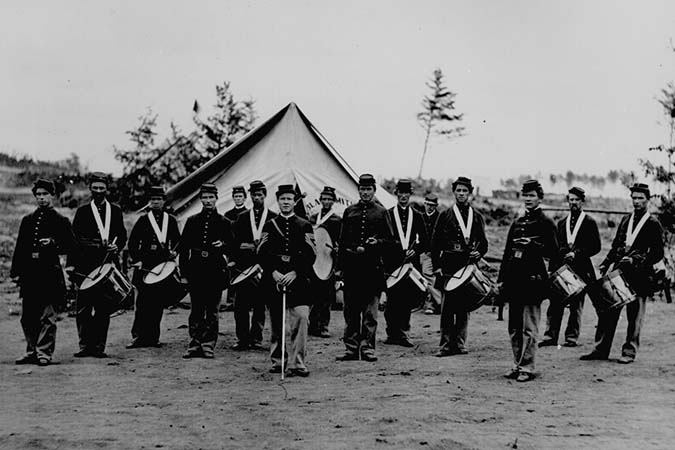
A faded black and white photograph depicts a line of determined musicians. Some hold fifes, others have drums slung over their shoulders. Their faces, a mix of concentration and stoicism, are turned forward.
The men wear weathered uniforms, some adorned with faint regimental insignia, hinting at a bygone sense of unit pride amidst the war's harsh realities.
A Union Observation Balloon is Prepped for Reconnaissance
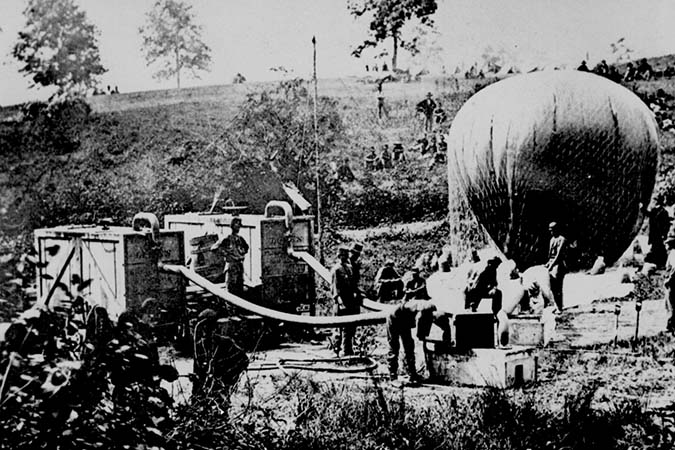
During the Civil War, the Union Army pioneered the use of air power for reconnaissance, conducting missions over Confederate territory with hot air balloons.
Here, soldiers are seen inflating one of these balloons. This photograph really captures the innovation that was necessary to win the war.
Union General (and Future President) Ulysses S. Grant Poses in Cold Harbor, VA

Union General Ulysses S. Grant is seen in this photo following the Battle of Cold Harbor, where he lost thousands of his men.
His face, etched with fatigue, reflects the weight of command. Despite the devastating time, his unwavering gaze hints at the determination that would bring him to the White House.
Captured Confederate Gun Boat, Atlanta, on the James River
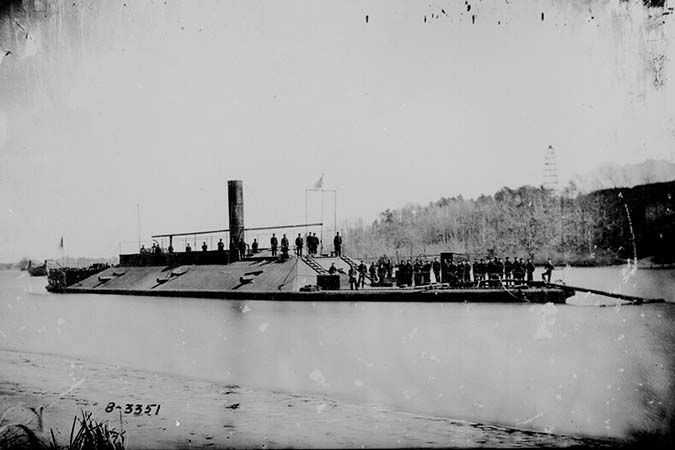
The once-proud Confederate gunboat Atlanta rests motionless in the water, surrendered to Union forces. Union soldiers stand proudly on the ship, a victory bringing them one step closer to ending the war.
As a captured vessel, the Atlanta serves as a silent testament to the Union Navy's growing dominance over the vital waterway.
Union Soldiers at the Battle of Fairfax Courthouse

This image shows a group of Union soldiers in front of the Fairfax courthouse. When you first look at this scene, it seems calm.
The truth behind this moment in time is crushing, however. The Battle of Fairfax Courthouse saw the first fatal casualties of the war in a land engagement. So much destruction was yet to come.
The McLean House, Site Where Robert E. Lee Surrendered the Confederate Army

A worn photograph shows the simple, two-story structure of the McLean house. Not only was history made here, but a future began.
Here, on April 9, 1865, Robert E. Lee rode in to surrender the Confederate Army, marking the end of the Civil War. The house stands as a silent testament to the war's resolution and the dawn of a new era.
Union Soldiers Prepare for Battle at Petersburg, VA

A gritty black-and-white photograph captures the tense moments before battle in Petersburg, Virginia. The soldiers' faces, a mix of determination and apprehension, reflect the gravity of the coming conflict.
Worn hats and uniforms hint at the long campaigns these men have endured. The scene is a stark reminder of the human cost of the Civil War.
Jefferson Davis' Home, Known at "The White House of the Confederacy"

A faded photograph shows the grandeur of Jefferson Davis' home, called the "White House of the Confederacy." Located on a bustling street corner, the three-story mansion features tall windows and a columned porch.
Though seemingly tranquil now, the image evokes a time of political upheaval and war. It’s hard to imagine what was going on behind those walls.
Confederate General Robert E. Lee Poses in 1865

A haunting portrait emerges from this black and white photograph. Confederate General Robert E. Lee, captured in 1865, stands tall. The lines in his face reveal the weight of command during the Civil War.
His gaze is distant, perhaps contemplative, hinting at the complex emotions swirling within him after the South's defeat. The photograph offers a glimpse into a man burdened by the war's heavy toll.
Union General George Custer Poses, Location Unknown

A faded photograph shows Union General George Custer in a serious mood. His sharp uniform contrasts with the worn backdrop.
Custer’s armed are folded over his chest, his gaze fixed firmly off to the side. The resolute set of his jaw suggests unwavering determination, perhaps even a hint of arrogance.
Union Soldiers Construct Telegraph Lines in Virginia
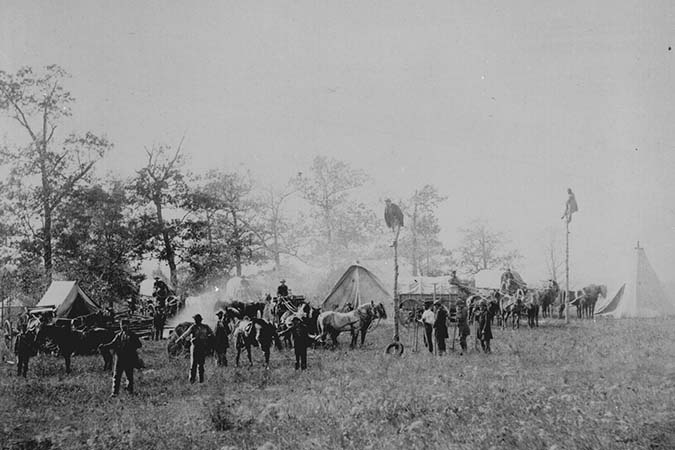
The telegraph, a relatively new invention at the time, played a significant role in the American Civil War. or the first time, commanders could receive and send messages with near real-time speed, revolutionizing communication on the battlefield.
Telegraphs enabled faster reporting of war news, keeping the public informed and governments aware of developments. The Union possessed a more extensive telegraph network, giving them a communication edge.
Union Maj. General Sheridan poses with his Generals in Front of His Tent

Union Major General Philip Henry Sheridan was known for his aggressive tactics and leadership, particularly in the later years of the Civil War. Starting as a captain, he rose to the rank of Major General in just six months due to his battlefield successes.
Sheridan's campaigns in the Shenandoah Valley, a crucial source of supplies for the Confederacy, were instrumental in weakening the South.
The 69th New York State Militia Observes Mass in Washington D.C.

Mobilized in April 1861 after the Confederate attack on Fort Sumter, the 69th New York State Militia participated in the early stages of the war, including the Battle of Bull Run in July 1861.
The unit with the most notable Civil War service is the 69th New York State Volunteers, which emerged from the militia and fought valiantly in many battles, earning the nickname "Fighting 69th."
Confederate "Quaker" Guns (aka Logs)

Quaker guns were a clever deception tactic used by the Confederates during the Civil War. They weren't actual guns, but rather logs or wooden beams painted black and shaped to resemble cannons.
The Confederacy often lacked sufficient artillery compared to the Union. By placing Quaker guns in fortifications, they hoped to fool the Union into believing they were more heavily defended than they actually were.
Fort Sumter, 1865
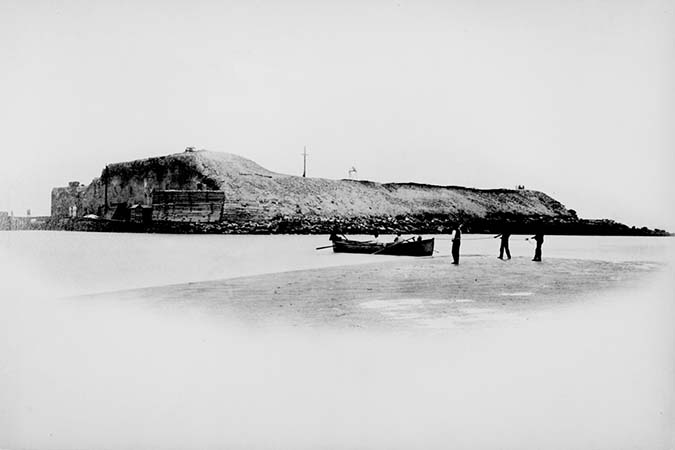
Fort Sumter, an unfinished federal fort in Charleston Harbor, South Carolina, played a critical role in starting the Civil War. Following South Carolina's secession in December 1860, tensions rose as a Union garrison held the fort.
Confederate bombardment in April 1861, despite causing no casualties, led to the fort's surrender and ignited the war. The battle became a symbol for both sides, solidifying their resolve and marking the war's bloody beginning.
Soldiers at Rest After Drill in Petersburg, VA, 1865

The Civil War wasn't all about fighting. Soldiers faced long stretches of downtime in camps, and keeping themselves occupied was a constant challenge. To combat boredom, they turned to simple pleasures.
Games like cards, checkers, and dominoes provided friendly competition and shared laughter. Letters from loved ones were a lifeline, and many soldiers filled the quiet hours with reading newspapers, novels, or even keeping diaries.
Soldiers in Front of Their Wooden Hut

Building winter quarters involved utilizing readily available resources. Soldiers primarily used logs or timber from nearby woods to construct rectangular cabins, typically around 16 feet by 16 feet, to house a small squad.
Dirt floors were common, though some cabins had wooden ones. Roofs were built with split boards or even canvas, and any gaps were filled with mud or clay to improve insulation against the cold. The most crucial feature was a fireplace.
The 26th U.S. Colored Volunteer Infantry, in Pennsylvania, 1865

The 26th U.S. Colored Volunteer Infantry was a regiment of African American soldiers who fought for the Union in the American Civil War.
Organized in February 1864 on Riker's Island in New York Harbor by the Union League Club of New York, they were part of a surge in raising African American regiments as the war progressed. The 26th U.S. Colored Volunteer Infantry engaged in several key battles, including John's Island (July 1864), Honey Hill (November 1864), and Tulifinny (February 1865).
Scouts and Guides for the Army of the Potomac in Berlin, MD, 1862

Scouts in the Civil War were akin to military spies. These brave individuals ventured ahead of the main army, often deep into enemy territory. Their primary mission was to gather intelligence on enemy troop movements, strengths, and positions. Skilled riders and marksmen, scouts were adept at navigating unfamiliar terrain and surviving on their own.
Guides, on the other hand, were the "local experts" for the armies. Often civilians deeply familiar with a specific region, they possessed invaluable knowledge of the terrain, roads, waterways, and landmarks. In essence, guides ensured the smooth movement and logistics of the army within the landscape.
General George Thomas and Officers Near Ringgold, GA, May of 1864
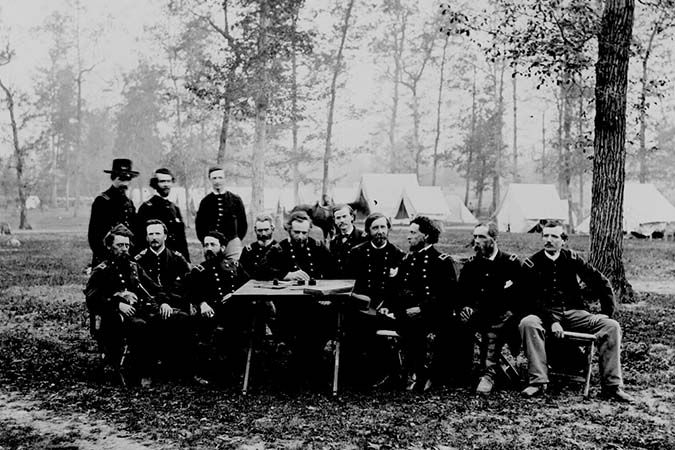
General George Henry Thomas, a Virginian by birth, defied his home state's secession to become a distinguished Union Army general during the Civil War. Primarily serving in the Western Theater, he was known for his strategic mind and defensive capabilities.
Early in the war, he secured a key victory at Mill Springs (1862) and played important roles in later battles. However, his most defining moment came at Chickamauga (1863).
Ward in the Carver General Hospital in Washington D.C.

Carver General Hospital was a hospital specifically serving the needs of the Union Army during the American Civil War. Records indicate it was built using converted wooden barracks, previously used by the 102nd New York Volunteers.
Carver General Hospital wasn't one of the larger or more well-known Civil War hospitals in Washington D.C. Historical records are scarce.
Baseball Game Between Union Prisoners at Salisbury, NC in 1863

Baseball played a significant role in keeping Union soldiers occupied and maintaining morale during the American Civil War. Baseball's popularity during the Civil War helped solidify its place as a national pastime.
The first documented wartime baseball game occurred in July 1861, between a Union regiment and a Washington D.C. civilian club. Newspapers reported on games played by Union soldiers throughout the war.
Army of the Potomac, Brandy Station, VA in Feb of 1864
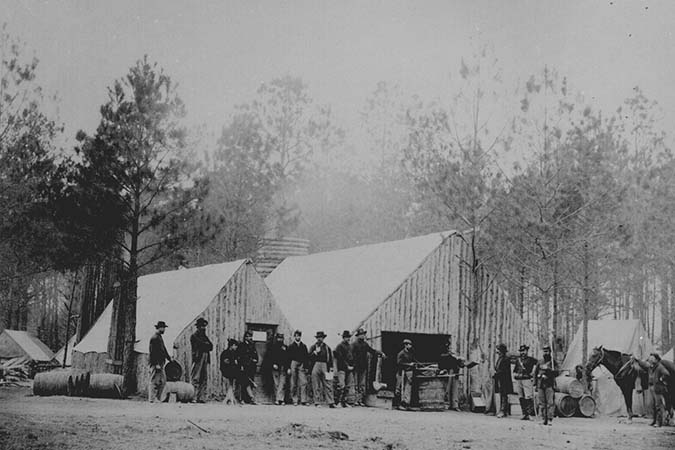
The commissary introduced essential provisions to soldiers, primarily food, but could also include some basic necessities. Soldiers received daily rations containing staples like hardtack crackers, salt pork, beans, coffee, and sugar.
While commissary supplies provided sustenance, soldiers often supplemented their diet by foraging or purchasing additional food from civilians whenever possible.
General Grant & General Meade Near Massaponax Church in VA, May 1864

Major General George Gordon Meade of the Union Army rose to prominence during the Civil War. Replacing General Hooker just before the Battle of Gettysburg in 1863, Meade's leadership and strategic decisions were instrumental in securing a pivotal Union victory, a turning point in the war.
While he remained in command until the war's end, his later actions, though successful, were sometimes criticized for caution.
The 26th New York Infantry at Fort Lyon

This image shows the Twenty-sixth New York Infantry at Fort Lyon, Virginia. The soldiers stand with their rifles raised, with the drummer boys off to the left.
The Grand Review
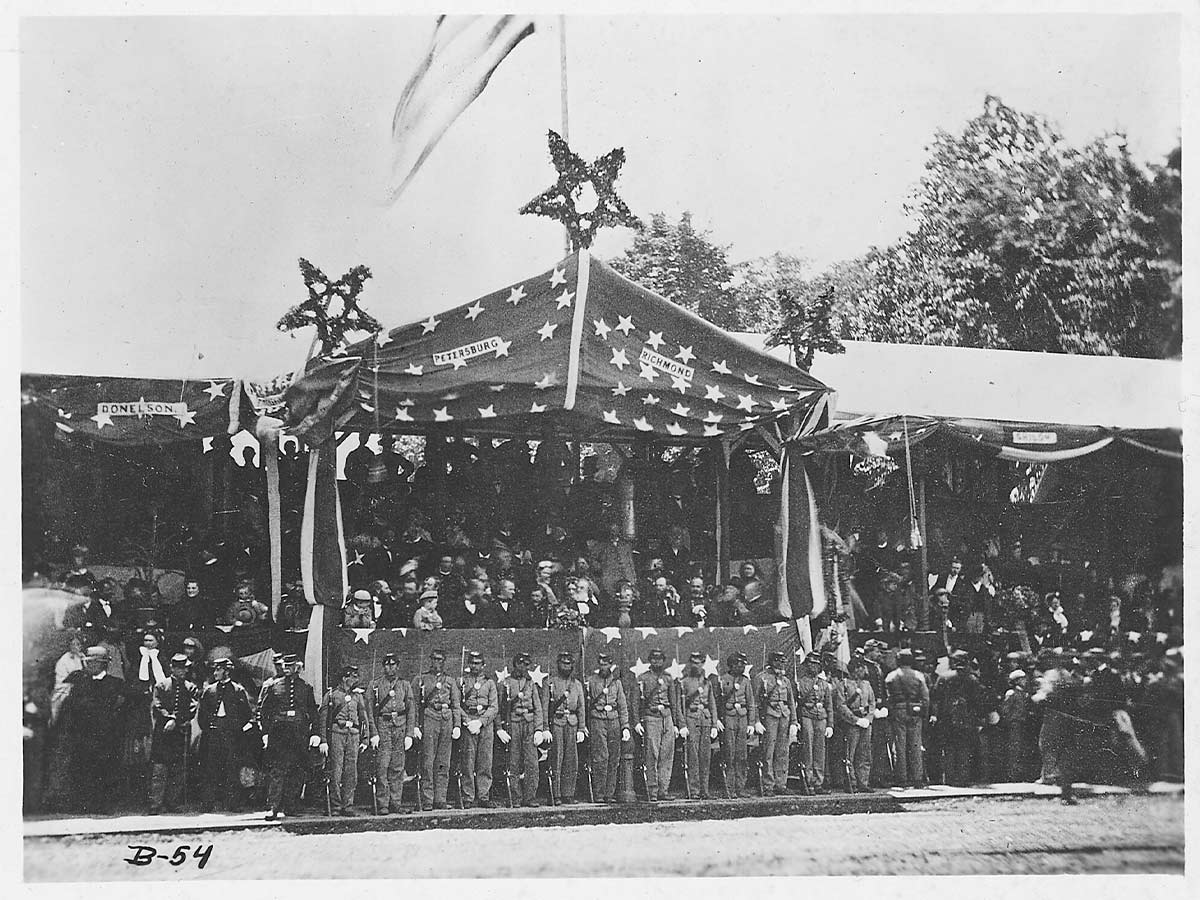
This photograph shows a reviewing stand for the Grand Review of the Armies, a military procession with over 145,000 Union soldiers parading down the streets of Washington, D.C. in 1865 following their victory.
In the stands are President Andrew Johnson, General Grant, and Colonel Ely Parker among others. The event took place in the weeks following the death of President Abraham Lincoln. The crowds contained a mix of grief for their murdered president and joy for the end of the Civil War.
 Author
Ron Winkler
Last Updated: August 10, 2025
Author
Ron Winkler
Last Updated: August 10, 2025